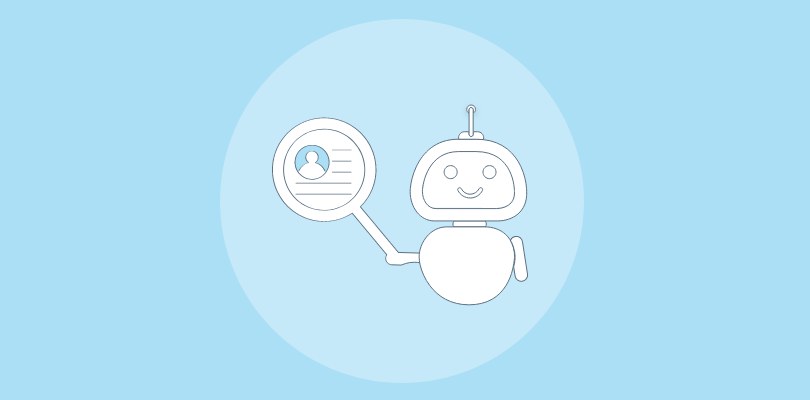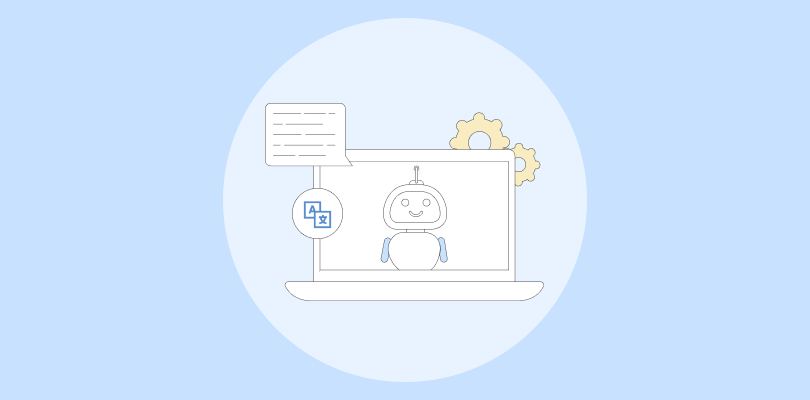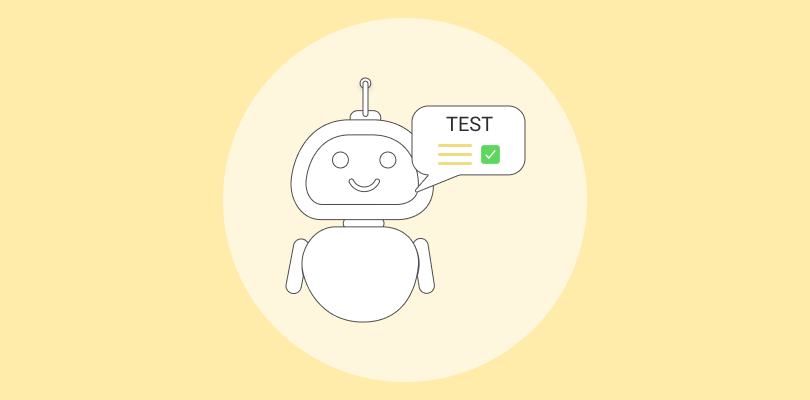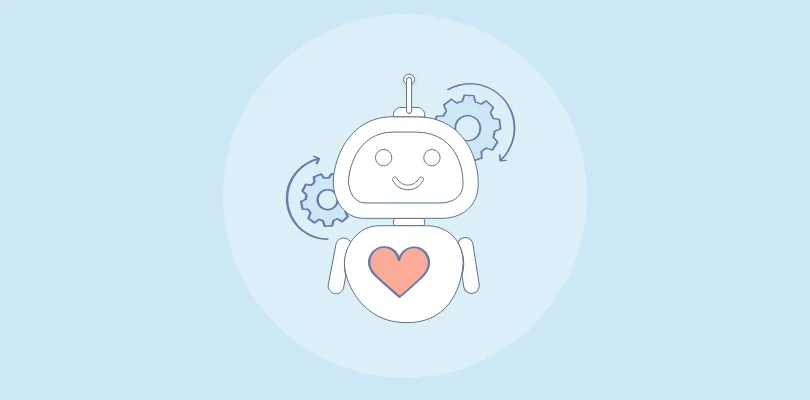As our customer base grew, I saw a clear pattern—our support team was answering the same questions repeatedly.
Common queries like:
• “What’s your pricing?”
• “How do I reset my password?”
• “How do I get started with your product?”
They were simple questions, but time-consuming. We tried using rule-based bots, but they lacked context and failed to meet customer expectations.
So I took a smarter approach.
I decided to train a chatbot with my own data, pulling directly from our FAQs, product documentation, and support articles.
The outcome? 24/7 accurate responses, reduced workload, and a smoother customer journey.
I’ll walk you through how we did it—it’s quick, simple, and straight from our own content.
Step-By-Step Guide: How to Train Your Chatbot
Training a chatbot isn’t just about feeding it data.
I’ll show you how to build a well-trained bot using ProProfs Chat and turn it into a smart, on-brand assistant that actually understands your business.
Step 1: Once you have logged in, go to the “Bots” tab in the dashboard, click “Create New Bot,” and pick the “Using AI” option.
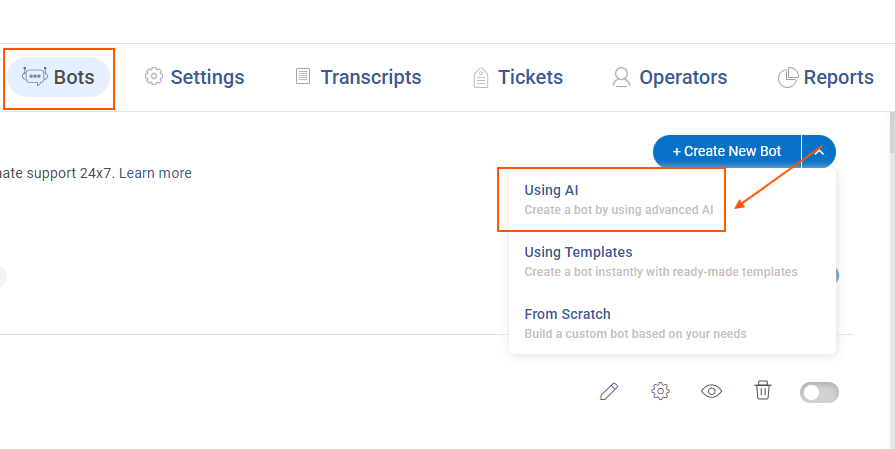
Step 2: Now, in this screen, you will see that you get three to four options to upload your data: website URL, uploaded files, plain text, or your Knowledge Base.
To show you how it’s done, I will use this link: [https://www.amazon.com/returnpolicy/] as the data source.
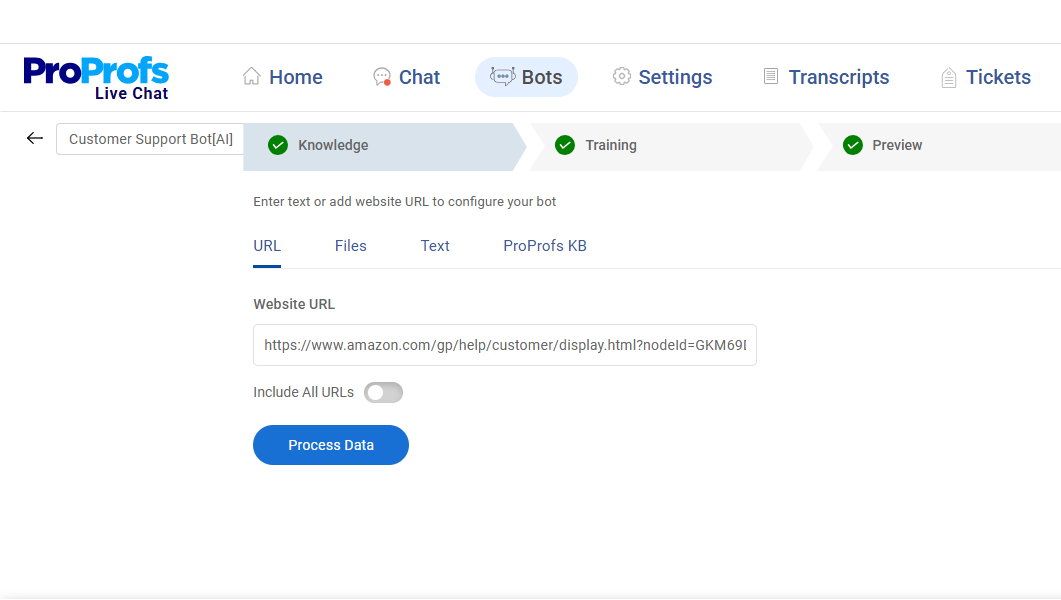
Once you’ve added your preferred data source, just click “Process Data” to continue. Here’s how the website content looks after processing:
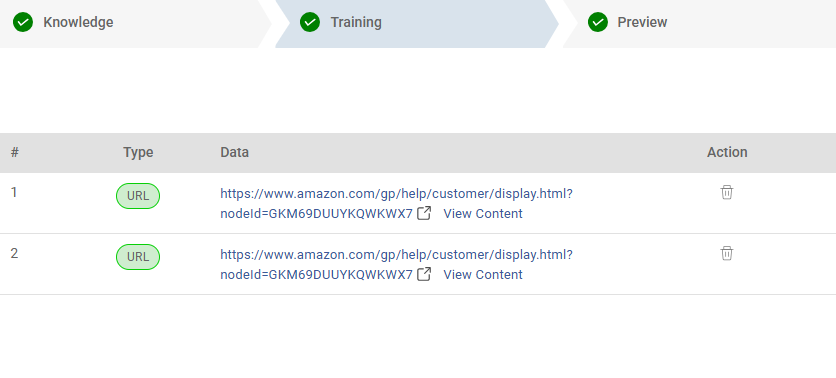
Step 3: Click “Preview” to test your bot’s response.
Let me quickly ask it a question to see how well it responds.
“Which items can’t be returned?”
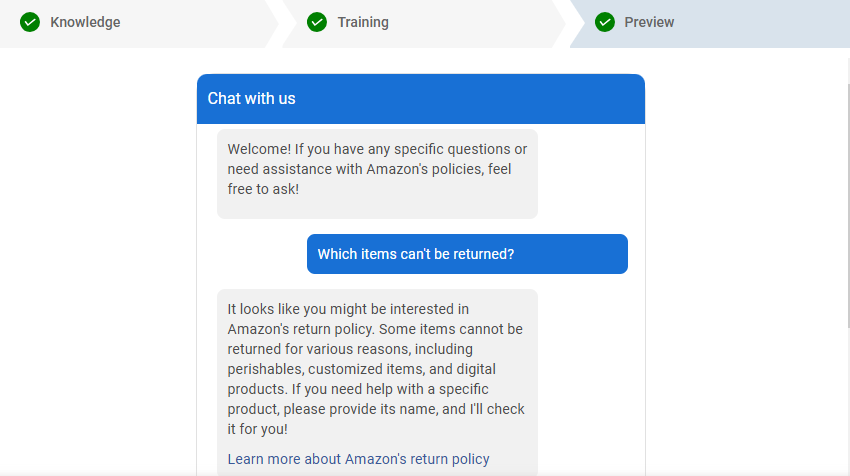
Voila! The chatbot is ready to provide accurate answers. This was just an example; you can try it with your own website data.
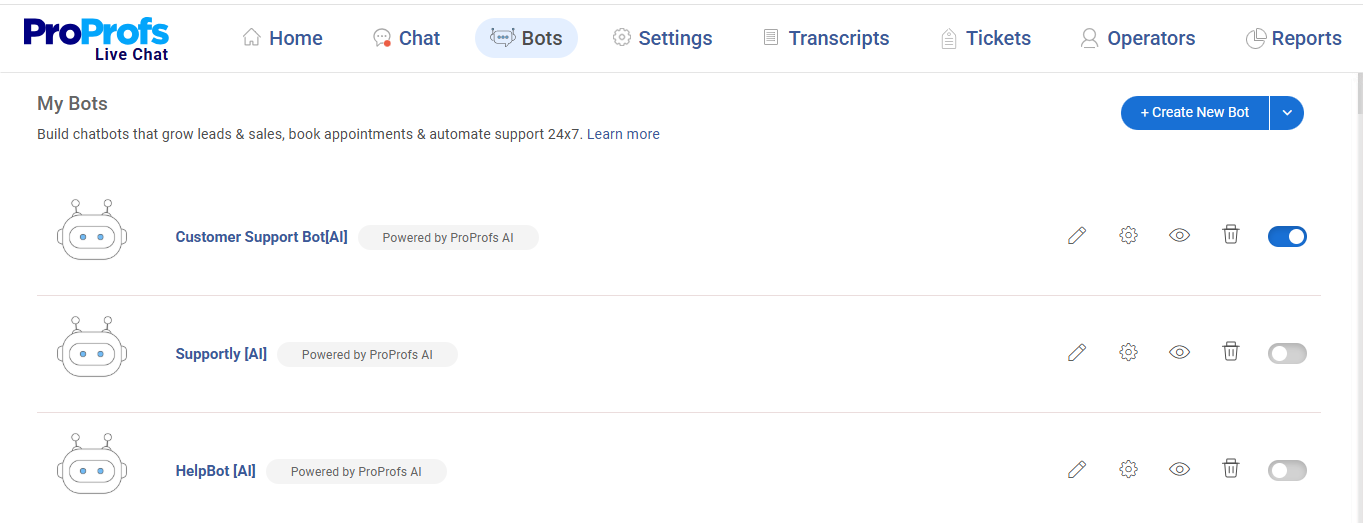
To retrain your chatbot in the future or modify other details, you can simply navigate to the “Bots” section and select your bot.
Why Train a Chatbot With Your Own Data?
Learning how to train a chatbot on your own data means you’re not just building a bot, you’re creating one that’s faster, more accurate, and aligned with your brand. Here’s why it’s a smart move:
- Delivers Accurate, Brand-Specific Answers
Generic bots often miss the mark. But when you train a chatbot using your FAQs, product pages, policy docs, and support articles, it replies the way your top rep would, minus the wait.
For example, with ProProfs AI Chatbot, you can just enter your website URL or upload documents, and the bot will be trained in minutes.
- Works 24/7 Without Human Supervision
Even in the middle of the night, the bot’s there to answer instantly. It can instantly respond to questions, book appointments, and even route requests to human agents when needed.
Based on simple options like Yes or No, the bot smartly escalates chats to agents or logs tickets automatically.
“Here’s a quick look at the appointment booking chatbot template:
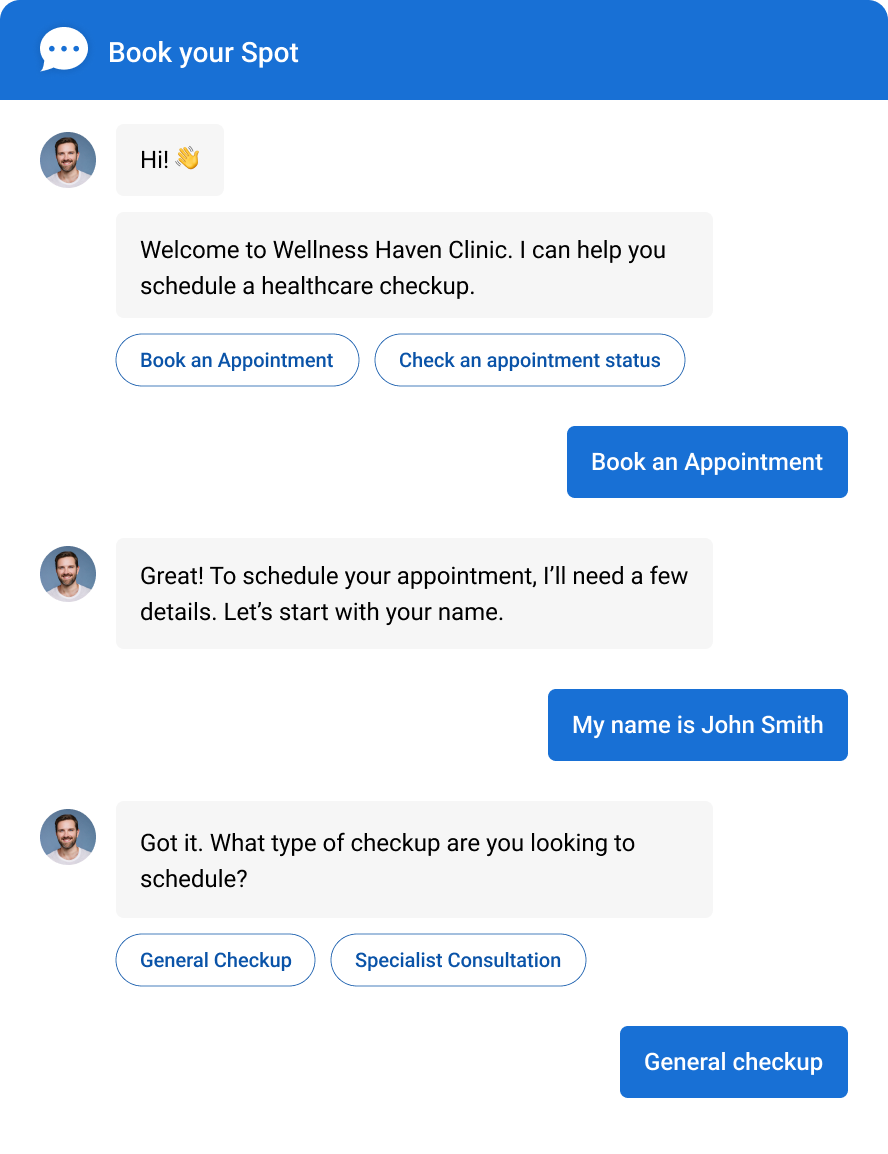
- Reduces Support Team Workload
Repetitive questions like “What’s your return policy?” or “How do I reset my password?” don’t need a human to answer them every time.
A chatbot trained on your internal knowledge base can handle these instantly, letting your support team focus on edge cases, complaints, or VIP customers.
This leads to faster response times and higher agent productivity.
- Boosts Lead Capture and Conversions
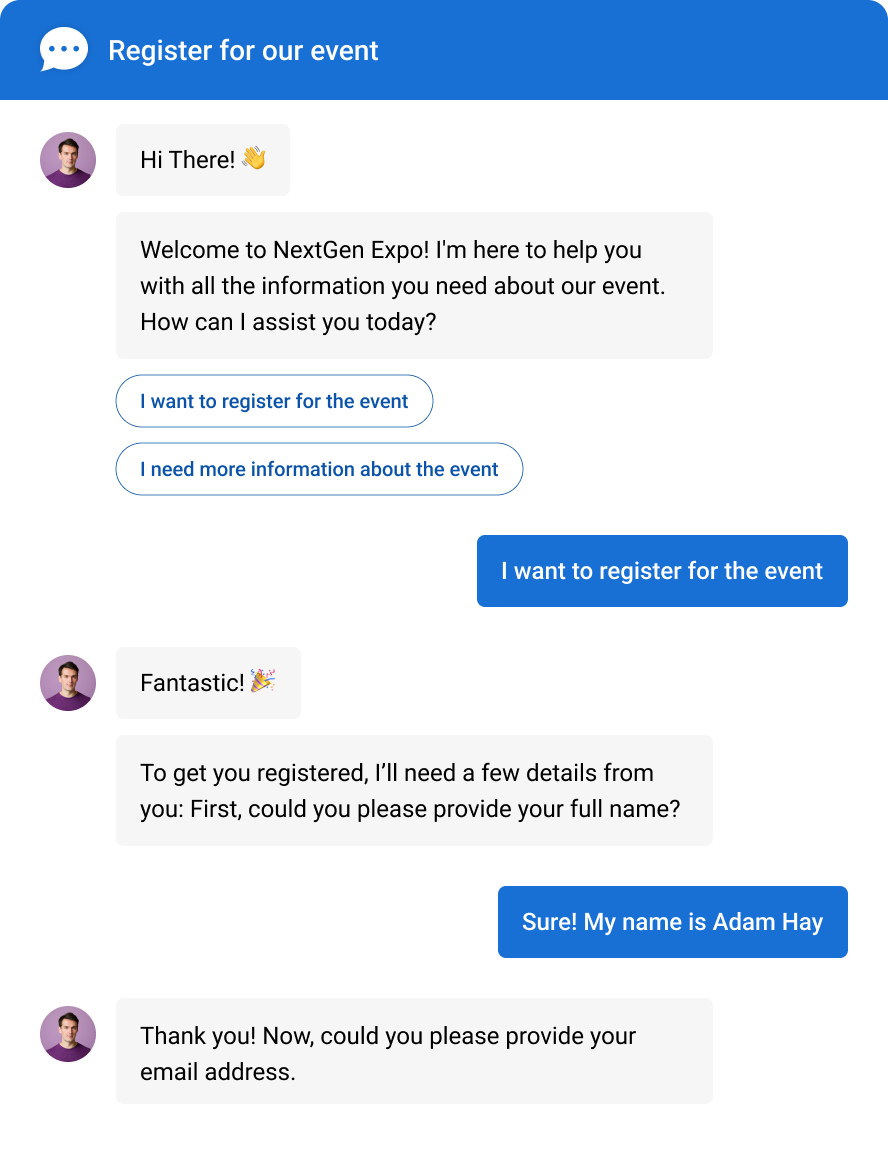
With pre-chat forms, CRM integration, and smart conversation flows, a well-trained chatbot can qualify leads and capture their details while answering questions.
It can trigger proactive chat invitations based on behavior, offer timely discounts, and prompt demo bookings at the right moment.
It makes support feel effortless and turns helpful conversations into conversion opportunities.
“Hi! Looking for a product recommendation?” → [Multiple Choice] → [Capture Email] → [Offer Discount Code]
- Improves Customer Experience Across Channels
A chatbot trained on your data doesn’t just live on your website—it can be deployed across WhatsApp, Facebook Messenger, Android, and iOS apps.
No matter where your customers engage, they get consistent, helpful, and context-aware responses. It’s like having a personalized support rep everywhere, instantly.
Types of Data You Can Use to Train Your Chatbot
To make your chatbot truly useful, you need to feed it the same content your team relies on—so it can respond with clarity, context, and confidence.
Below are the most effective data types that work best for training a chatbot.
| Data Type | Description |
|---|---|
| FAQs | Train the bot to answer common questions and reduce repetitive queries. |
| Product Info | Add details like features, pricing, and benefits to help with purchase queries. |
| Support Guides | Use manuals and how-tos so the bot can resolve issues quickly. |
| Company Policies | Include returns, shipping, and terms for consistent, accurate replies. |
| Workflow Steps | Add booking or onboarding steps so the bot can guide users smoothly. |
Top 5 Tools to Train Chatbots Using Your Own Content
After testing multiple AI chatbot platforms myself and speaking with founders, marketers, and tech teams, I’ve narrowed down the top 5 tools to train chatbots using your own content—whether that’s from websites, PDFs, FAQs, or help docs.
Before the deep dive, here’s a quick peek at the top 5 chatbot tools!
| Tools | Best For | Pricing | User Rating |
|---|---|---|---|
| ProProfs Chat | 24/7 Delightful Customer Support With AI Chatbots | A Forever Free plan with all premium features is available for small teams. Paid plan starts from $19.99/user/month. | 4.8 (Capterra) |
| BotPress | Conversational AI Solutions | Paid plans start at $89/month. | 4.6 (G2) |
| ManyChat | Making Chatbots for Messaging Apps | Paid plans start at $15/month. | 4.6 (Capterra) |
| Zendesk | Omnichannel Engagement | Starts at $19/agent/month. | 4.3 (G2) |
| Landbot | Structured Conversation Flows | Paid plan starts at $45/month. | 4.7 (G2) |
1. ProProfs Chat – Best for 24/7 Delightful Customer Support With AI Chatbots
A few years ago, I chose ProProfs Chat, which has been a core part of our support system ever since. I was able to train it using our own data, such as FAQs, website content, and internal documents, so the responses are always relevant and accurate without needing constant updates.
For more complex queries, the bot offers multiple-choice options like Yes/No. Based on the user’s input, it either connects them to a live operator or automatically logs a support ticket. I also use customizable chatbot templates for lead capture, customer support, and appointment scheduling.
Setting everything up was super easy. I created custom workflows, refined the bot’s responses, and made sure they matched our brand’s tone. It’s made a real difference in helping us generate leads and support customers 24/7.
Pros:
- Canned responses to quickly address common customer queries
- Automatic chat routing to transfer chats to the appropriate agents
- Pre-chat forms to gather information and qualify leads
- Seamless integration with Google Meet for video interactions
Cons:
- Lacks an on-premise version
- The dark user interface option is not available
Pricing: A Forever Free plan with all premium features is available for small teams. Paid plan starts from $19.99/user/month.
User Rating: 4.8 (Capterra)
User Review:
“Easy to process, professional, and very user-friendly. The customer service is awesome as well.” – Lakeisha, Human Resource Manager (Capterra)
See how Horse Saddle Shop boosted support, sales, and global reach with ProProfs Live Chat.

2. BotPress – Best for Conversational AI Solutions
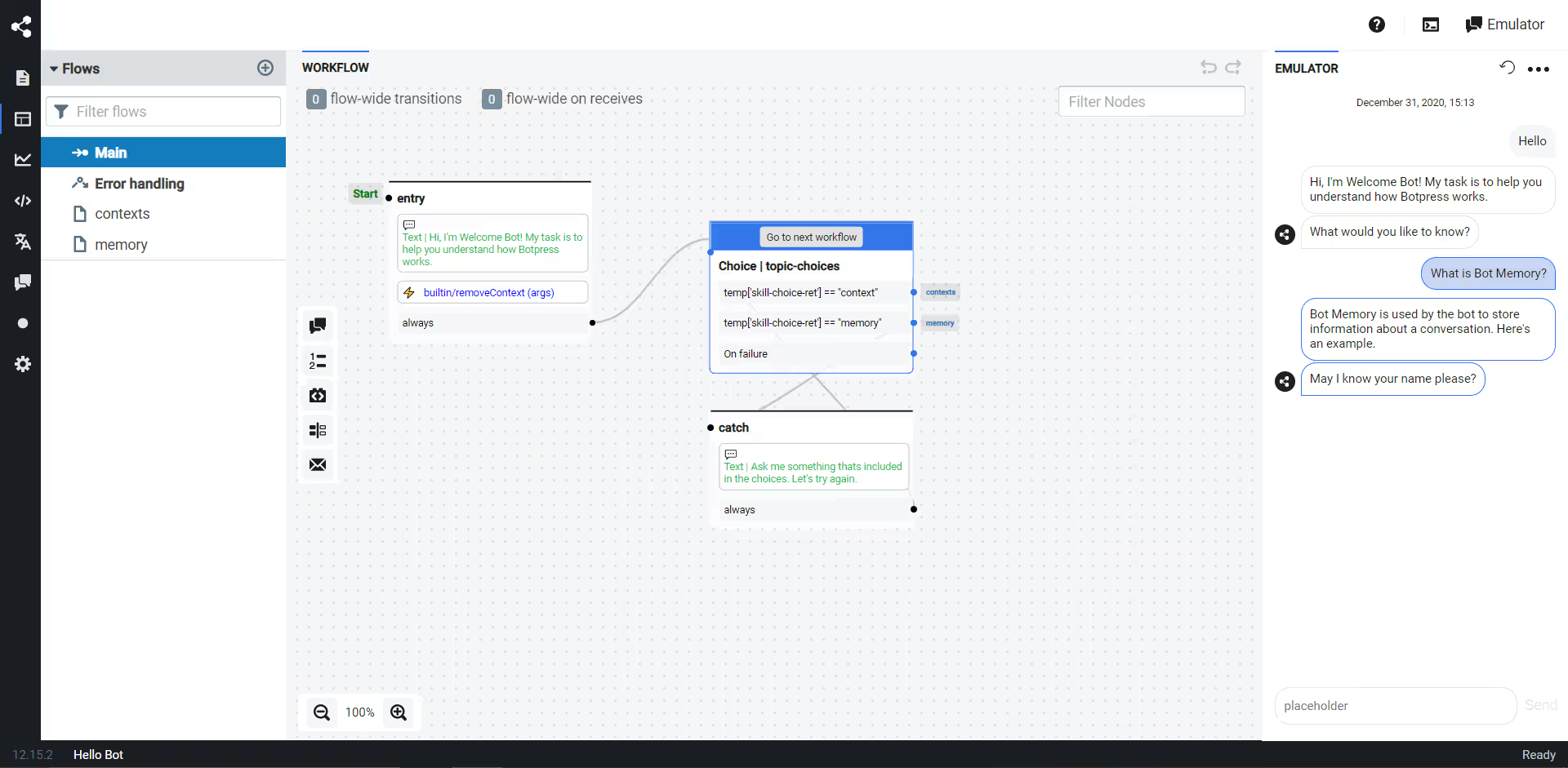
Image Source: Saasworthy
If you’re looking for a more advanced chatbot tool and don’t mind spending some time learning it, BotPress is a good choice. It’s made for teams that want full control over how their chatbot works and are comfortable with technical setups.
Just like I did with ProProfs Chatbot, you can train your BotPress chatbot using your own data—like FAQs, documents, or website content—so it can answer detailed and specific questions.
The main difference is that ProProfs Chat was easy to set up and train quickly. BotPress takes more time to understand and use properly. It’s not as simple, but once you learn it, you can build a chatbot that fits your exact needs.
It also includes helpful features like data control, custom flows, and API support, which make it a strong option for businesses that need a more flexible chatbot.
Pros:
- Offers full control with custom workflows and modular bot logic
- Includes built-in NLU (Natural Language Understanding) for smarter conversations
- Supports API and webhook integrations with external systems
- Allows version control for tracking bot updates and changes
Cons:
- Limited customer support for free users
- It can be overwhelming for small teams without technical resources
Pricing: Paid plans start at $89/month.
User Rating: 4.6 (G2)
User Review:
“I was able to create a Chatbot for my work assignment. My chatbot was meant to help with AI Fundamentals, and with the Knowledge base tool and AI Task tool I was able to create a Chabot with coding.” – Zoe L., IT Support Specialist (G2)
3. ManyChat – Best for Making Chatbots for Messaging Apps
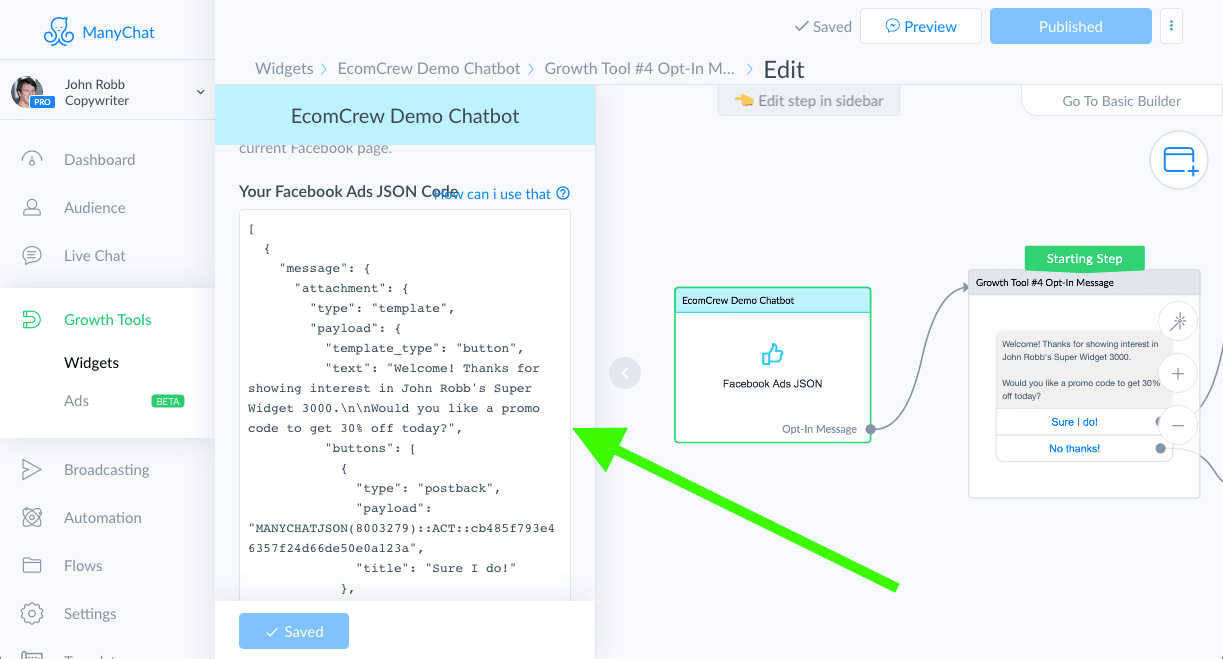
Image Source: Ecomcrew
I’ve used ManyChat when I needed a chatbot that could connect directly with customers on platforms like Instagram, Messenger, and WhatsApp—and it delivered. It’s designed for marketing and engagement, not just basic support.
I was able to train the chatbot using our product details and past conversations, so the replies felt on point and relevant.
What I liked most is how easy it is to set up. The visual editor is super intuitive—no tech skills needed. Within minutes, I had a bot ready to answer questions, follow up on leads, and even automate parts of our sales funnel.
If your audience lives on social media, ManyChat is a great way to meet them and keep the conversation going.
Pros:
- Easy-to-use visual editor with no coding needed
- Lead automation to capture leads and automate follow-ups with ease.
- Social Platform Integration to engage users on Messenger, Instagram, and WhatsApp
- Built-in tools to automate lead nurturing and sales follow-ups
Cons:
- Limited use beyond messaging platforms
- Some useful features require a paid subscription
Pricing: Paid plans start at $15/month.
User Rating: 4.6 (Capterra)
User Review:
“I have been using Manychat for several years and I must admit that it is the market leader for the chatbot sector, I find it a very useful tool for creating interesting workflows, perfect for lead generation and for creating fantastic funnels.” – Ettore, Manager (Capterra)
4. Zendesk – Best for Omnichannel Engagement
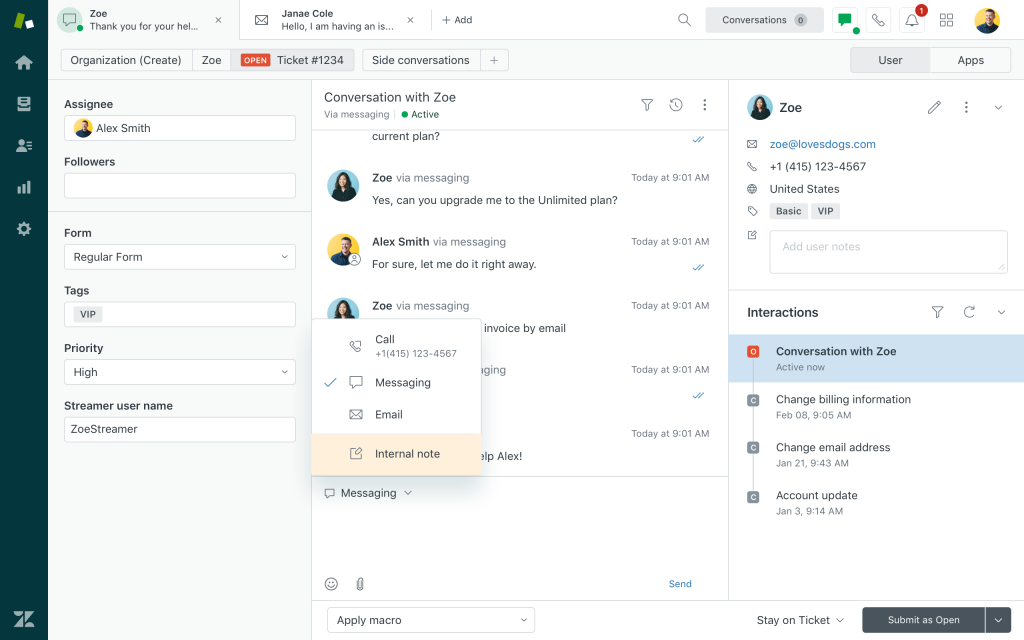
Image Source: Getvoip.com
I explored Zendesk when I needed a chatbot that could do more than just answer basic questions. What impressed me was how easily it pulls from our help center, macros, and past tickets to train itself—so the setup felt familiar and aligned with how our support team already worked.
It’s designed for fast responses, smart routing, and handing off issues to live agents when needed.
Zendesk works well across web, email, and social messaging apps, and supports multi-language use out of the box. If you’re running a support-heavy operation and already use Zendesk, the AI agent is a powerful add-on. Just know that some features require technical skills or a higher-tier plan.
Pros:
- Conversation routing to automatically directs chats to the right agent or department
- Multi-language support to communicate with users in different languages
- Omnichannel integration to work across email, web, messaging apps, and social media.
- Seamless human handoff to transfer complex queries to live agents with full context.
Cons:
- Some advanced features need coding or developer support.
- Full AI capabilities are only available in premium plans.
Pricing: Starts at $19/agent/month.
User Rating: 4.3 (G2)
User Review:
“The system easily integrated with our ZD CRM, and the reporting and intraday functionality is very user-friendly. My management team uses it daily with very little to no issues.” – Luis O., Head Of Customer Service (G2)
5. Landbot – Best for Structured Conversation Flows
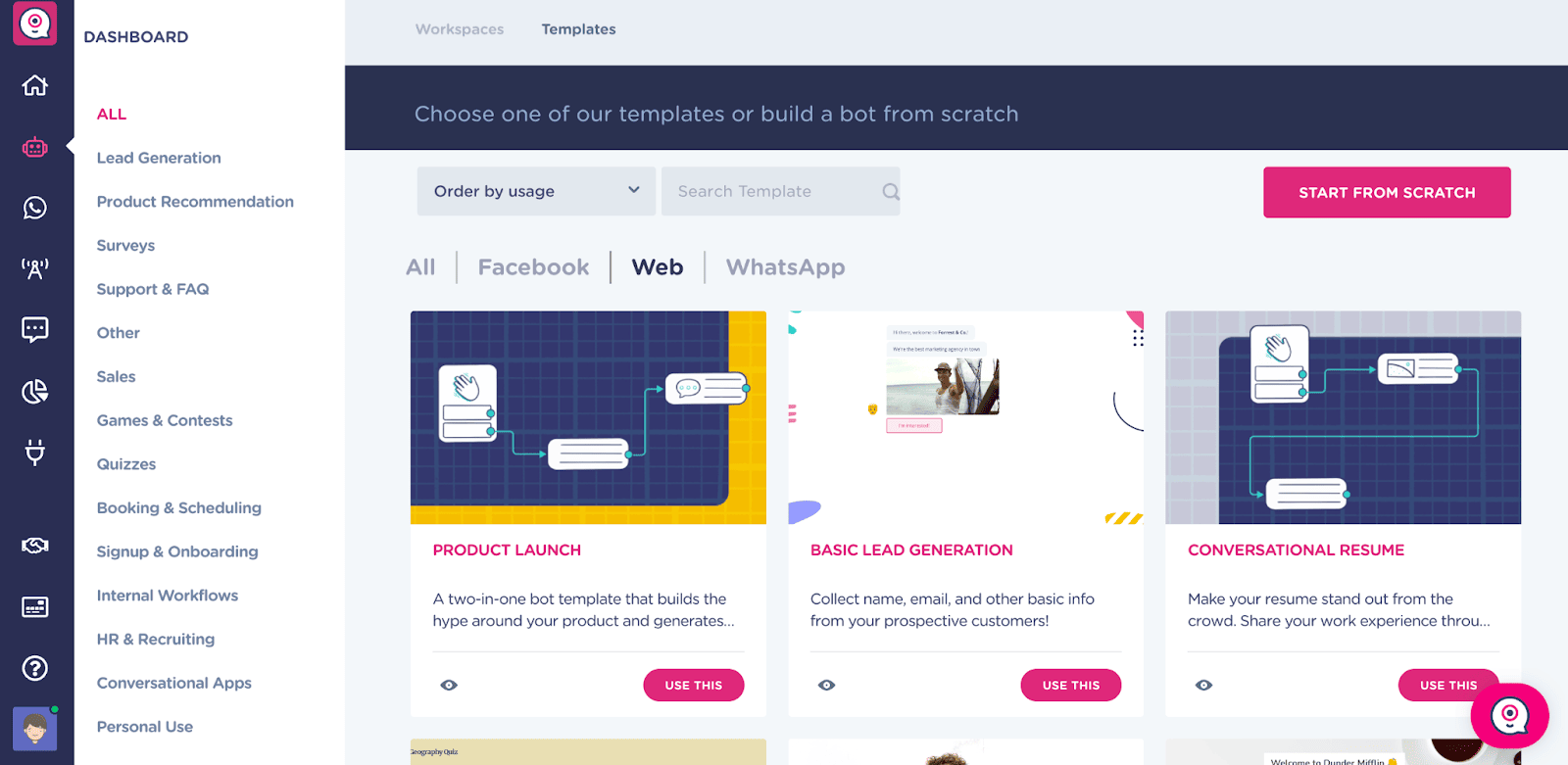
Image Source: Landbot
Landbot is best for creating structured conversation flows while now offering powerful AI agent capabilities. The platform lets you train the AI by uploading PDFs, adding custom text, or connecting URLs from my website. This data becomes the chatbot’s knowledge base, helping it respond accurately and naturally to user questions.
What I love about Landbot is how it blends traditional no-code chatbot building with powerful AI. These aren’t just button-click bots—they actually understand free-text input and use GPT-style models for more natural conversations. I can fine-tune the AI’s personality to match my brand and easily deploy it on my website or WhatsApp.
It’s also easy to connect Landbot with tools like HubSpot or Google Sheets for real-time automation. If needed, my AI agent can smoothly transfer chats to human support agents or capture leads with pre-chat forms.
Pros:
- Visual flow builder to easily create chat logic with a drag-and-drop interface
- WhatsApp & Messenger Integration to deploy bots on popular messaging platforms
- Real-time analytics to track performance and user interactions live
- CRM & Zapier integration to automate workflows and connect with business tools
Cons:
- Not ideal for deep NLP or custom training
- Advanced features cost more as usage grows
Pricing: Paid plan starts at $45/month.
User Rating: 4.7 (G2)
User Review:
“Landbot is the next thing on the market of the lead generation. I personnaly use it as landing pages for ads, and when you know how to use it, it works perfectly and is really competitive compared to other tools.” – Denis B., Traffic Manager (G2)
FREE. All Features. FOREVER!
Try our Forever FREE account with all premium features!
Four Chatbot Training Challenges & How to Fix Them
You can’t just flip a switch and expect perfect answers. Training your chatbot takes some planning. Here’s what to watch for.
1. Inaccurate or Generic Responses
Challenge: If your chatbot isn’t trained on the right content, it may deliver vague or off-brand answers.
Fix: You can train your chatbot using your own data, such as FAQs, product pages, and help articles. Several tools let you upload this content or pull it directly from your website or knowledge base, so responses stay relevant and accurate.
2. Outdated Information in Replies
Challenge: Business details change, but your bot may still be sharing old information.
Fix: You can easily update chatbot responses and sync them with your knowledge base. This keeps your chatbot aligned with your latest offerings and policies.
3. Missed Escalations for Complex Questions
Challenge: When the bot can’t handle a query, users can get stuck or drop off.
Fix: Tools like ProProfs Chat offer smart fallback options, such as routing chats to live agents or automatically submitting tickets, so conversations never reach a dead end.
Watch how a chatbot hands off to agents without missing a beat.
4. Not Knowing If the Bot’s Ready
Challenge: It’s tough to tell whether your chatbot understands user queries until it’s live.
Fix: You can test your bot responses before launch, so you can fine-tune workflows and ensure the experience feels seamless.
Power Smarter Chatbot Responses With the Right Training Data
Training a chatbot with your own data isn’t just a technical upgrade, it’s a smarter way to scale support and improve customer experience.
Now that I’ve shown you how to build a custom chatbot with your own data, you’re probably excited to start creating multiple bots in just minutes.
The key is to begin with clear, consistent resources like FAQs, product info, support tickets, and internal docs. I tested early, refined responses, and kept improving based on real conversations.
For anyone looking to do the same, I recommend using ProProfs Chat. It lets you train your chatbot with your website and knowledge base content without needing to code, so you can deliver fast and accurate support around the clock.
Frequently Asked Questions
Can I train a chatbot to work with multiple languages?
Yes, modern chatbot platforms often support real-time language translation. This allows your bot to interact with users in their preferred language and deliver consistent experiences across regions.
Can I integrate my trained chatbot with WhatsApp or CRM tools?
Most advanced chatbot tools offer native integrations or APIs for WhatsApp, Facebook, and CRMs like Salesforce or Zoho. This lets you sync data, route chats, and maintain consistent conversations across platforms.
What if I want the chatbot to escalate chats to a human agent?
You can set rules to trigger a live chat handoff when the chatbot is unable to resolve a query. The conversation is then seamlessly transferred to an available human agent for further assistance, ensuring a smooth customer experience.
How do I ensure my chatbot is GDPR-compliant?
To stay GDPR-compliant, configure your chatbot to collect consent before gathering personal data. Ensure the platform offers features like secure data storage, role-based access, and options to export or delete customer information upon request.
FREE. All Features. FOREVER!
Try our Forever FREE account with all premium features!

 We'd love your feedback!
We'd love your feedback!
 Thanks for your feedback!
Thanks for your feedback!


